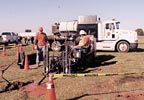Rich Maxwell warns that if you think "enlarging the hole" is all that back reaming is about, you are missing several important functions of back reaming.
Back reaming is a part of almost every horizontal directional drilling (HDD) operation. I say "almost every" because there are times when the operator is installing small cable that simply involves pulling the product back through a hole that is already considerably larger than the outside diameter (OD) of the cable. But, by and large, HDD involves the process of drilling a pilot hole; taking the drill head and locator assembly off at the exit pit; attaching a larger tool we will call a reamer; and pulling the reamer back through the hole -- enlarging the hole to the desired OD. Sometimes the conditions allow you to pull the product at the same time on that first pass by attaching the product to a swivel, which is mounted behind the reamer.

|
|
Cross Country Underground shown drilling at the recent HDD Rodeo event in Perry, Ga. |
To many of you, this is redundant conversation. But if you think "enlarging the hole" is all that back reaming is about, you are missing several important functions of back reaming, which gets lot of operators in trouble because they think all they have to do is attach a reamer and pull pipe.
Back reaming isn't just about cutting a larger hole and pulling pipe or cable. That's what it looks like, and when you look at down hole tool advertisements, that's what the ads say they do. But as my long-time friend Ron Becker, a seasoned driller, described it to me many years ago, "Back reaming is preparing the bore hole," developing the hole for the product being installed.
To keep this discussion simple, there are at least two additional functions of back reaming besides enlarging the hole -- slurring up the hole and developing integrity in the bore-wall.
Many bores go south because the operator doesn't know or doesn't consciously set out to develop the proper slurry mixture in the hole. The hole dries up because it's mostly water and not a good mixture of bentonite and/or polymers. Secondly, the hole caves in because the bore wall has been ignored, with no provisions made for "wall cake" or wall compactions.
Related Articles
Time doesn't allow me to get into detail on how you do each of these and a dozen other techniques such as stage reaming and avoiding hydrolocking. Some other time we may talk about the difference between cutting a hole and compacting a hole. And the process Ron Becker taught me about where you cut a larger hole almost to the entry pit and then remove those (clay-type) cuttings by pushing the reamer and the cuttings back out the exit pit like a big long "Baby Ruth." Back reaming also is a process, which involves selecting the proper tools (cutter, packer, mixer) that may be a part of the reaming process.
One other overlooked part of preparing the hole is if you wait until you put your back reamer on to start thinking about proper mud mixture, you're screwed. Consider how much fluid you use on the pilot hole. That drilling fluid mixture already is in the hole. Mud engineers will tell you how to anticipate swelling and allowances for porosity and inadvertent returns, but if you wait until you have the pilot bore done to start thinking about this, you already have a certain amount of drilling fluid in the hole. Even if you enlarge the hole from 5 to 24 inches, you still have started with a certain chemical reaction and a diluting effect is taking place with that first 300 to 600 gallons of drilling fluids already pumped into the hole on the pilot bore. The point here is to make the pilot bore a part of the reaming process.
Lubricity, wall integrity, sealing off the hole, packing spoils and removing spoils all should be considered in the part of HDD we call back reaming -- developing the hole.
Report Abusive Comment